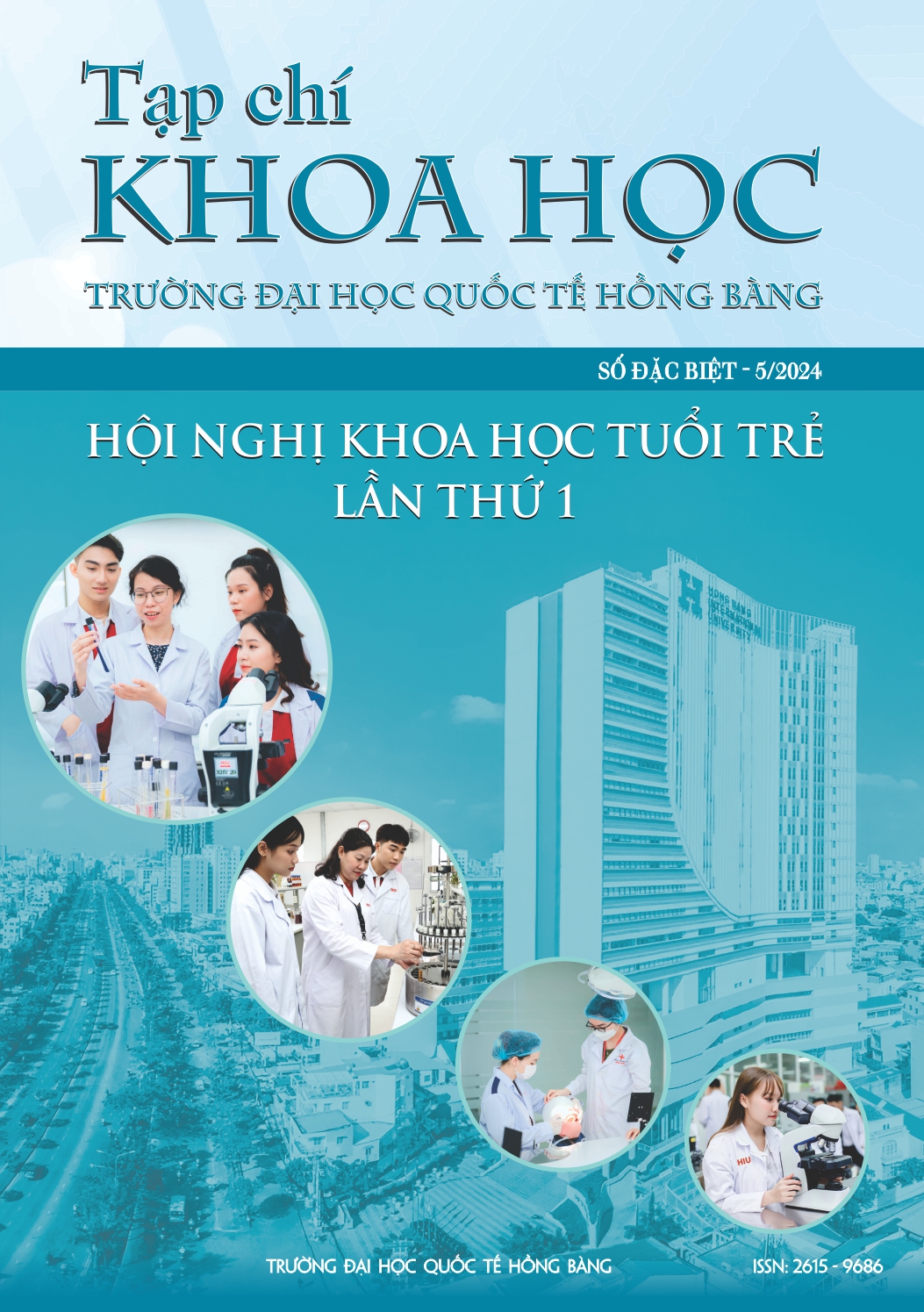ĐÁNH GIÁ KẾT QUẢ CHĂM SÓC ĐIỀU TRỊ TRẺ SƠ SINH SUY HÔ HẤP THỞ MÁY TẠI BỆNH VIỆN NHI ĐỒNG 1 VÀ CÁC YẾU TỐ LIÊN QUAN NĂM 2023
Các tác giả
DOI: https://doi.org/10.59294/HIUJS.KHTT.2024.012Từ khóa:
trẻ sơ sinh, suy hô hấp, thở máy. biến chứng do thở máyTóm tắt
Thở máy là một giải pháp cần thiết để hỗ trợ hô hấp cho trẻ sơ sinh bị suy hô hấp. Nghiên cứu cắt ngang mô tả trên 518 trẻ sơ sinh suy hô hấp tại Bệnh viện Nhi Đồng 1 từ tháng 05 đến 09/2023. Mục tiêu (1) Xác định tỷ lệ trẻ sơ sinh suy hô hấp có thở máy (2) Xác định tỷ lệ kết quả chăm sóc điều trị trẻ sơ sinh suy hô hấp thở máy (3) Xác định các yếu tố liên quan đến kết quả chăm sóc điều trị trẻ sơ sinh suy hô hấp thở máy. Kết quả: Trong tổng số 518 trẻ suy hô hấp: Có 8.3% thở máy xâm lấn và 14.3% thở máy không xâm lấn. Trong số 117 trẻ có thở máy: có 68.4% nằm viện ≥ 14 ngày; có 98.3% thở máy thành công (xuất viện ổn); có 53.8% trường hợp xảy ra biến cố bất lợi gồm: Tràn khí màng phổi 0.8%, Tụt nội khí quản 9.3%, Tổn thương niêm mạc đường hô hấp 9.3%, Thở máy kéo dài 35.6%, Tổn thương da 41.0%. Mô hình hồi quy đa biến ghi nhận các yếu tố liên quan đến biến cố bất lợi bao gồm tình trạng hô hấp khi nhập viện (PR = 0.65, p = 0.034); chiều dài trẻ (PR = 1.82, p = 0.007); đặt catheter tĩnh mạch trung tâm (PR = 2.88, p < 0.001). Kết luận: Các biến chứng trong quá trình thở máy cần được quan tâm hơn.
Abstract
Mechanical ventilation is a necessary solution that provides respiratory support for newborns with respiratory failure. This descriptive cross-sectional study on 518 newborns with respiratory failure was conducted at Children's Hospital 1 from May to September 2023. Objective: (1) Determine the rate of newborns with respiratory failure receiving mechanical ventilation, (2) Determine the rate of care and treatment outcomes for newborns with respiratory failure receiving mechanical ventilation, and (3) Identify factors related to the results of care and treatment for newborns with respiratory failure and mechanical ventilation. Results: In a total of 518 children with respiratory failure: 8.3% were on invasive mechanical ventilation and 14.3% were on non-invasive ventilation. A total of 117 children required mechanical ventilation: 68.4% were hospitalized for ≥ 14 days, and 98.3% had successful mechanical ventilation (stable discharge from hospital). There were 53.8% adverse events, including: Pneumothorax 0.8%, Endotracheal intubation 9.3%, Respiratory mucosal damage 9.3%, Prolonged mechanical ventilation 35.6%, Skin damage 41.0%. The multivariable regression model identified factors related to adverse events, including respiratory status upon admission (PR= 0.65, p= 0.034), child length (PR= 1.82, p=0.007), and central venous catheter placement (PR= 2.88, p<0.001). Conclusion: Complications during mechanical ventilation require more attention.
Tài liệu tham khảo
[1] Lei, Y., Qiu, X. & Zhou, R. “Construction and evaluation of neonatal respiratory failure risk prediction model for neonatal respiratory distress syndrome”, BMC Pulm Med 24, 8 (2024).
DOI: https://doi.org/10.1186/s12890-023-02819-4[2] World Health Organization, “Newborns: improving survival and well being”, Report, UK, 2020.
[3] Henderson-Smart, D. J., Wilkinson et al. “Mechanical ventilation for newborn infants with respiratory failure due to pulmonary disease”, The Cochrane database of systematic reviews, 2002(4).
DOI: https://doi.org/10.1002/14651858.CD002770[4] Sood S, Ganatra HA, Perez Marques F and Langner TR, “Complications during mechanical ventilation—A pediatric intensive care perspective”, Front. Med, 2023.
DOI: https://doi.org/10.3389/fmed.2023.1016316[5] Nguyễn Phan Trọng Hiếu, “Đánh giá kết quả điều trị suy hô hấp sơ sinh và một số yếu tố liên quan”, Tạp chí Y học Việt Nam tập 515, tháng 6, số 1, tr.83-89, 2022.
DOI: https://doi.org/10.51298/vmj.v515i1.2680[6] Ramadan A. Mahmoud, “Non-invasive ventilatory support in neonates: An evidence-based update, Paediatric Respiratory Reviews”, Volume 44, December 2022, Pages 11-18, 2022.
DOI: https://doi.org/10.1016/j.prrv.2022.09.001[7] Tổng Cục Thống Kê, “Tỷ số giới tính của trẻ em mới sinh phân theo vùng chia theo Vùng và Năm”, báo cáo, 2022.
[8] Trần Tiến Thịnh, “Một số yếu tố liên quan đến kết quả điều trị ở trẻ sơ sinh thở máy tại Bệnh Viện Trung Ương Thái Nguyên”, Tạp chí Nhi Khoa, 16, 4, Tr.40-46, 2023.
DOI: https://doi.org/10.52724/tcnk.v16i4.226[9] Trần Thị Thanh Nhàn, “Đánh giá kết quả điều trị suy hô hấp ở trẻ sơ sinh non tháng bằng thông khí áp lực dương liên tục qua mũi tại Bệnh viện Nhi đồng Cần Thơ năm 2022-2023”, Tạp chí Y dược học Cần Thơ, số 62, Tr.194-200, 2022.
DOI: https://doi.org/10.58490/ctump.2023i62.1243[10] G. D. Inglis, L. A. Jardine, M. W. Davies, "Prophylactic antibiotics to reduce morbidity and mortality in ventilated newborn infants", Cochrane Database Syst Rev, 3, pp.1-5, 2007.
DOI: https://doi.org/10.1002/14651858.CD004338.pub3[11] Võ Thị Xuân Hương, “Nghiên cứu đặc điểm lâm sàng, cận lâm sàng và đánh giá kết quả điều trị suy hô hấp cấp ở trẻ sơ sinh non tháng bằng phương pháp thở áp lực dương liên tục qua mũi tại bệnh viện nhi đồng Cần Thơ năm 2016 –2018”. Luận văn chuyên ngành Nhi Khoa. Trường Đại học Y Dược Cần Thơ. 2018. 49-71, 2018.
[12] Sahussarungsi S., Techasatid W, “Predicts of early nasal continuous positive airway pressure (CPAP) failure and consequences in preterm infants in Thammasat University Hospital”, J Med Assoc Thai,100, 46-50. 2018.
[13] Özlem Arman BİLİR, ÜNAL Sevim, Eda ÖZAYDIN, Fatma Çakmak ÇELİK "Neonatal mechanical ventilation: indications, complications and outcome", Türkiye Çocuk Hastalıkları Dergisi, 3(4), pp. 46-52, 2015.
[14] S. Yadav, B. Lee, R. Kamity. Neonatal Respiratory Distress Syndrome. StatPearls. StatPearls Publishing, 2023.
[15] Václav Vafek, Tamara Skříšovská et al. “Central venous catheter cannulation in pediatric anesthesia and intensive care: A prospective observational trial", Children, 9(11), pp. 1611, 2022.
DOI: https://doi.org/10.3390/children9111611Tải xuống
Tải xuống: 121











